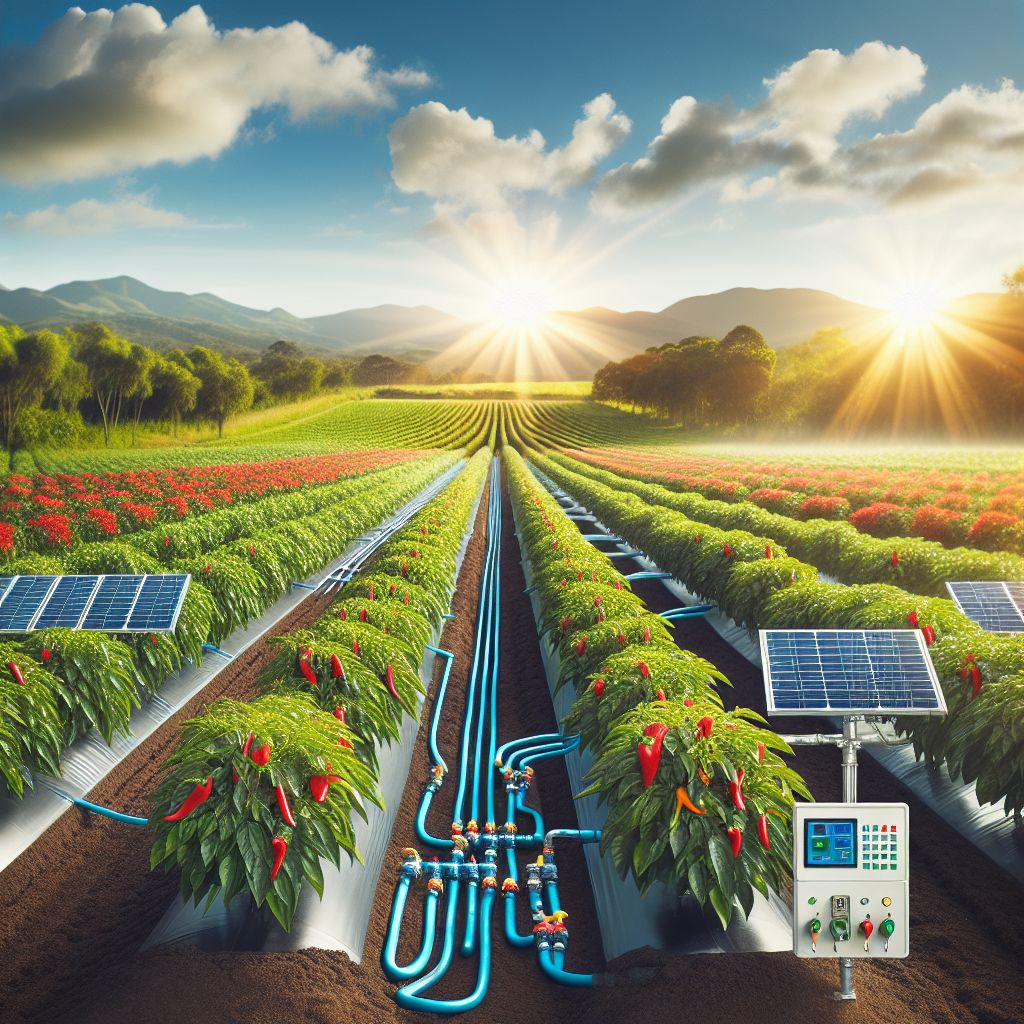
Welcome to the world of solar irrigation systems, designed specifically for growing peppers. If you’re interested in increasing your pepper yield, reducing energy costs, and moving towards sustainable farming, you’ve come to the right place. Whether you’re an experienced farmer or just starting out, this guide is designed to make the concept of solar-powered irrigation easy to understand and implement.
Key Takeaways
Solar irrigation systems provide a green method to maintain a steady water supply for peppers.
By utilizing solar power, farmers can decrease operational expenses and lessen their carbon emissions.
Peppers thrive with systems such as drip irrigation, which can be effectively run by solar panels.
Investing in the appropriate type of solar panels can optimize efficiency and output for pepper farms.
Comprehending the long-term financial advantages of solar irrigation is vital for making knowledgeable choices.
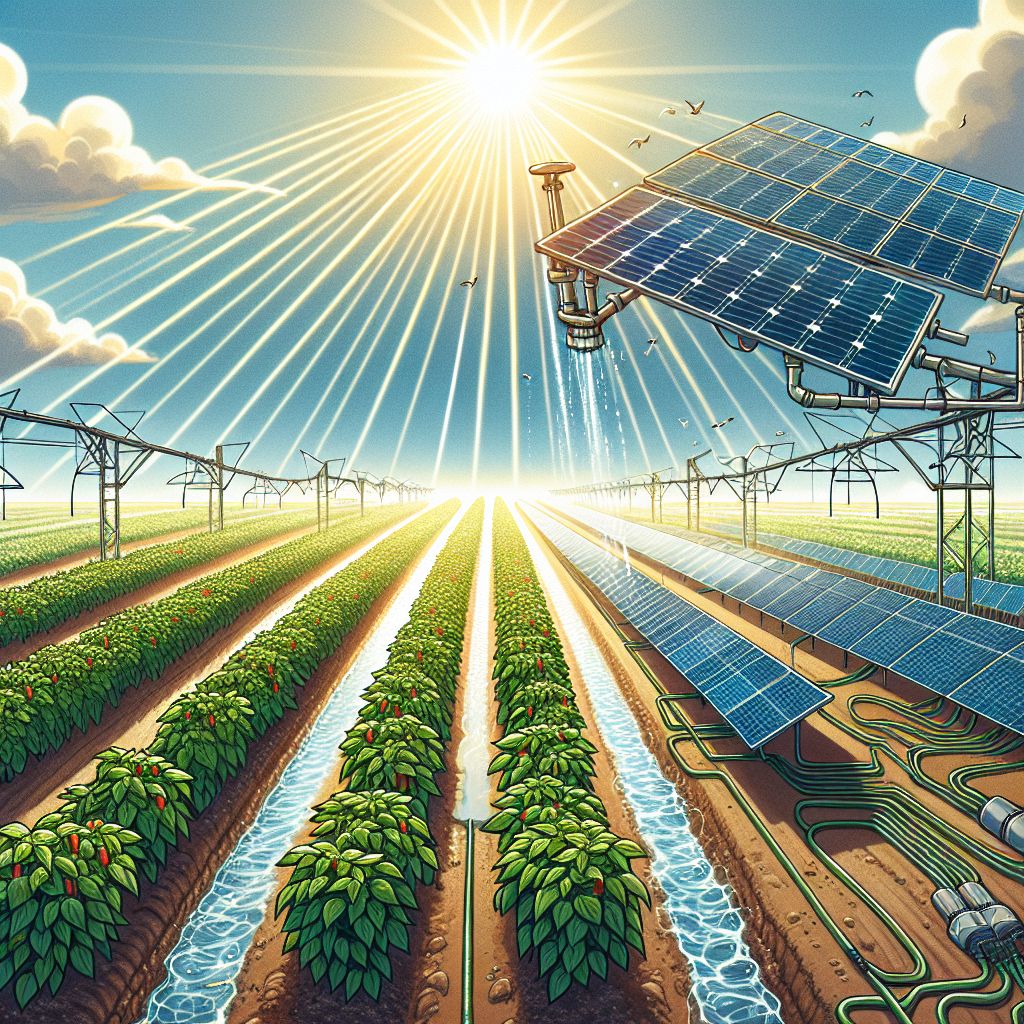
The Reason to Pair Solar Panels with an Irrigation System
When considering growing peppers, water and sunlight are seen as two vital components. So, why not harness the sun not only to grow peppers but also to energize the very system that waters them? This is the role of solar irrigation. It’s a perfect pairing, offering a dependable water source for your plants while keeping energy expenses low.
Using Renewable Energy for Eco-Friendly Farming
By using solar panels to run your irrigation system, you’re utilizing an unlimited source of energy. The sun provides your farm with energy every day, and with the correct system, you can use that energy to water your pepper plants. This is a wise decision that is in line with sustainable farming methods and contributes to environmental protection.
Lowering Your Expenses with Solar Power
Let’s get real about costs. Conventional energy sources can be expensive, and their prices are only going up. Solar power, however, is free once you’ve installed your system. Yes, there’s an initial cost, but consider it a long-term investment. In the long run, the money you save on your energy bill can be significant, which is good for both your bank account and your farm’s bottom line.
Improved Harvest Results with Regular Watering
Like most crops, peppers do well with regularity. A solar-powered irrigation system can offer a regular source of water, which is key for good growth and a high harvest. And because you’re not dependent on the grid, you’re protected from power outages and changing energy prices. This means your peppers get what they need, when they need it, regardless of the circumstances.
Boosting Energy Self-Sufficiency in Farming
When you choose to install a solar irrigation system on your farm, you’re not just helping your own crops. You’re also contributing to a wider push towards energy self-sufficiency in farming. This is a change that has wide-ranging impacts, from strengthening our national energy security to setting an example for other farmers. It’s a significant move towards a more robust and independent farming industry.
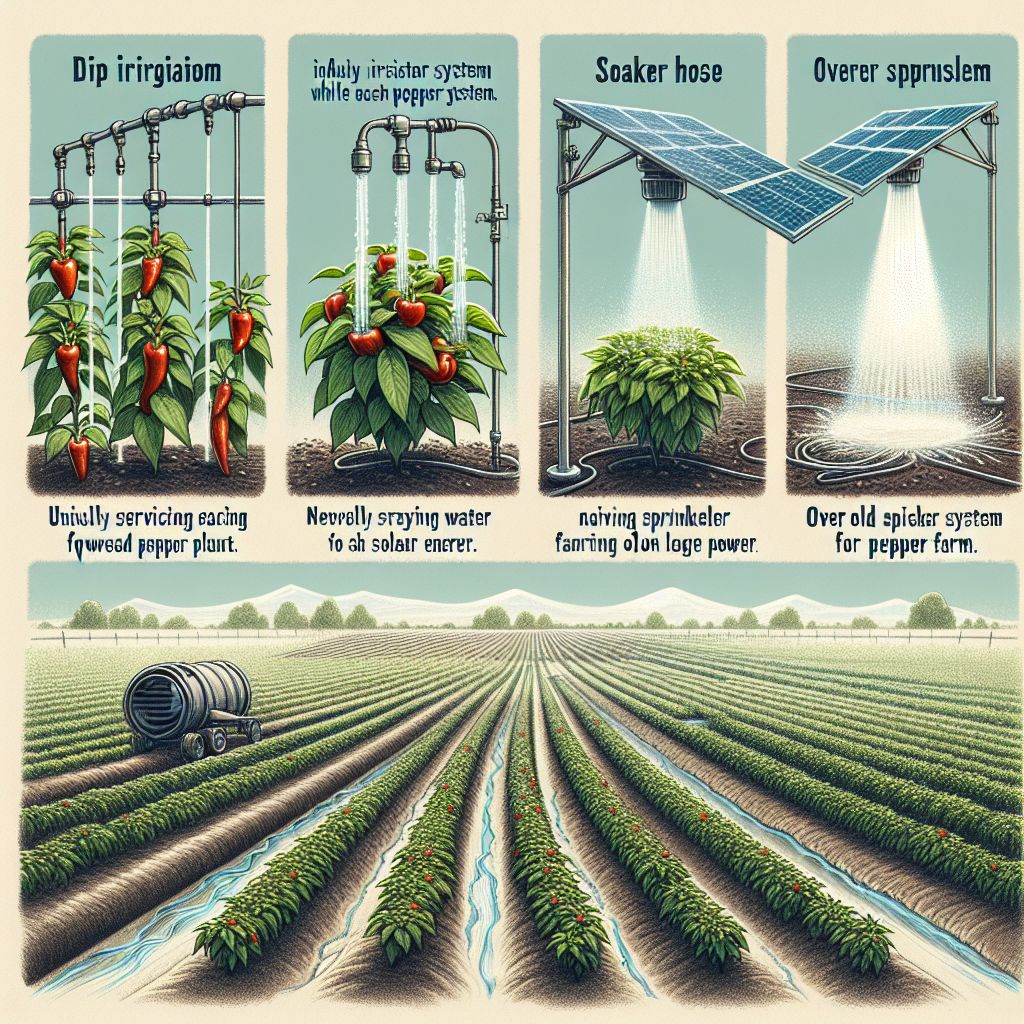
Various Irrigation Systems for Pepper Cultivation on a Farm
All irrigation systems aren’t the same, especially when it comes to cultivating peppers. The system you select can greatly affect water efficiency, plant health, and overall yield. Let’s examine the choices.
Drip Irrigation: The Ideal Watering Solution for Pepper Plants
Drip irrigation has revolutionized farming for many. It provides water right to the root of each pepper plant, reducing waste and making every drop count. This focused method saves water and also lessens the chance of disease from overhead watering. When run on solar power, drip irrigation is a low-cost, high-efficiency system that’s hard to top.
Sprinkler Systems: Overhead Irrigation for Larger Farms
Sprinkler systems are a common way to irrigate peppers on larger farms. These systems use a network of pipes and sprinklers to distribute water over a wide area. Sprinkler systems can be automated to water crops on a regular schedule.
Furrow Irrigation Systems: The Traditional Irrigation System for Growing Peppers on a Farm
Furrow irrigation is a traditional irrigation method that has been used for centuries to grow crops. It is a simple and effective way to water plants, and it is still widely used today on farms around the world.
Here is a table summarizing the pros and cons of different irrigation systems for growing peppers:
|
Irrigation System |
Pros |
Cons |
|---|---|---|
|
Drip Irrigation |
– Efficient water usage, minimizes evaporation and runoff. 1, 3, 4 |
– Initial installation can be expensive. 1, 3 |
|
Sprinkler/Overhead |
– Inexpensive to install. 1, 4 |
– Promotes foliar diseases on pepper plants. 1, 4 |
|
Furrow/Flood |
– Simple system, low installation cost. 1, 3 |
– Very high water usage. 1, 3 |
The best irrigation system for your farm will depend on the size of your operation, the type of soil you have, and the climate in your area. If you are not sure which irrigation system is right for you, consult with a local agricultural extension agent or a qualified irrigation specialist.
These insights have given you a good start on appreciating the advantages and uses of irrigation for pepper cultivation. Keep reading for the next section, where we’ll explore in more depth the cost savings and efficiency of traditional versus modern irrigation systems.
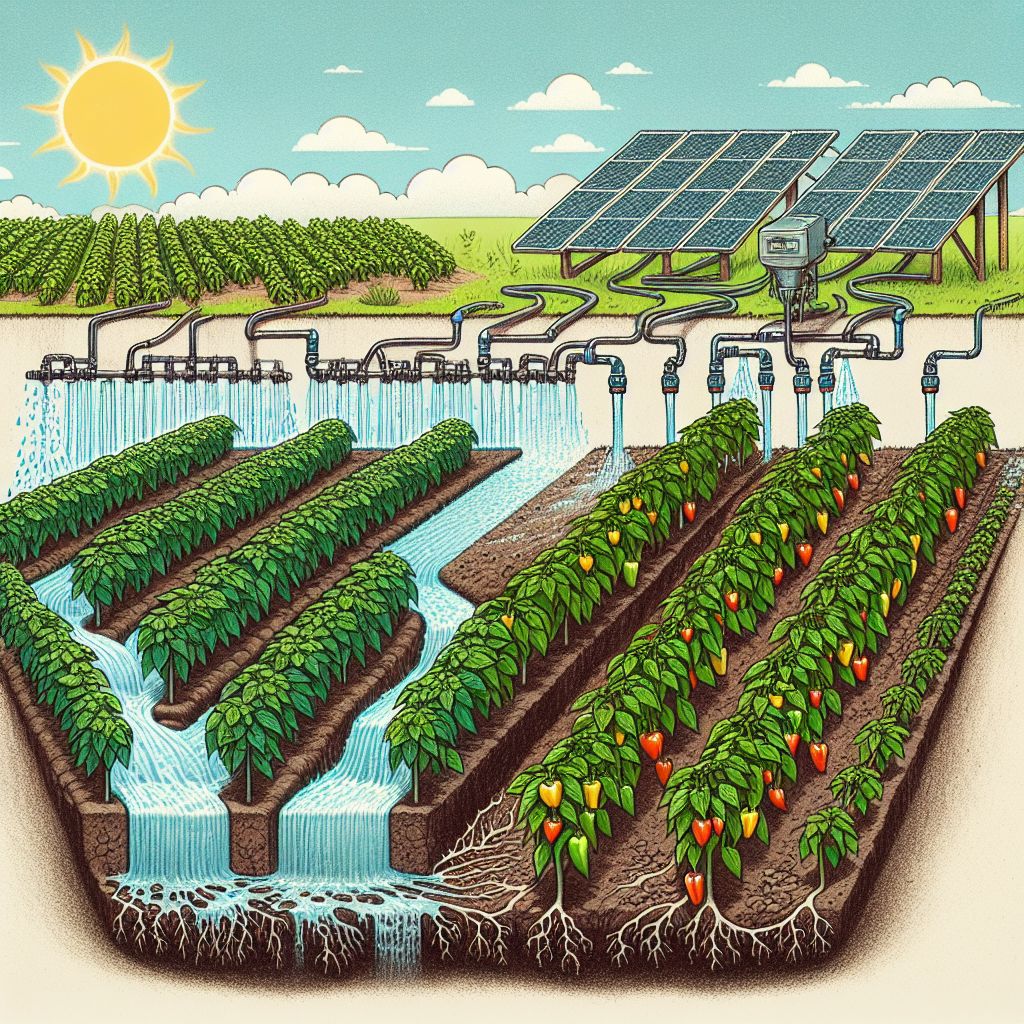
Cost and Increased Efficiency: Traditional Versus Modern Irrigation Systems for Growing Peppers
Peppers are a popular crop for both home gardeners and commercial farmers. They are relatively easy to grow, but they do require adequate water to produce a good yield. Traditional irrigation systems, such as furrow or sprinklers irrigation, can be effective, but they can also be inefficient and wasteful. Modern irrigation systems, such as drip irrigation or subsurface irrigation, are more efficient and can help growers save money on water and energy costs.
The Cost of Continuing to Use Outdated Methods
It’s no secret that sticking with old irrigation methods is like throwing money away. Conventional systems like furrow irrigation don’t just use a lot of water; they also need a lot of manpower and upkeep. This outdated way can result in patchy watering, water waste from runoff, and higher bills because of the inefficient use of resources.
Is it Worth Investing in Advanced Irrigation Systems?
While advanced irrigation systems are designed to conserve water and reduce labor, their initial costs can be intimidating. However, they are a worthwhile investment in the long run, as they save on water, energy, and labor costs. Many of these systems can also be integrated with solar power, which further improves their efficiency and cost-effectiveness.
Comparing Water Usage Efficiency in Various Systems
Modern irrigation systems, such as drip irrigation, are far more efficient than traditional methods. Drip systems can save up to 60% more water than conventional ones. Furthermore, they deliver water directly to the root zone, reducing evaporation and runoff. This level of precision ensures that each drop of water is used to nourish your peppers, resulting in healthier plants and higher yields.
Old-fashioned furrow irrigation: Uses a lot of water, can cause runoff and evaporation.
Overhead sprinkler systems: Distributes water better but can still evaporate and be blown away by the wind.
Drip irrigation: Very efficient because it waters the root zone directly, with very little waste.
Now, think about what would happen if you combined the efficiency of a drip irrigation system with the power of the sun. You would have a sustainable, cost-effective solution that would ensure the success of your pepper farm.

Various Solar Panels to Consider for Your Pepper Farm’s Irrigation System
It’s important to choose the right solar panels for your irrigation system. You need a reliable source of power that can meet the needs of your farm. There are a few different solar panels to choose from, each with its own advantages.
When choosing solar panels, it’s important to consider their efficiency, price, and durability, as well as how much space you have available on your farm. It’s also worth considering the climate in your area, as some panels work better in certain weather conditions than others.
Monocrystalline solar panels: These panels are known for their high efficiency and long lifespan, but they are also more expensive.
Polycrystalline solar panels: These panels are a cheaper option, but they are slightly less efficient.
Thin-film solar panels: These panels are flexible and lightweight, making them ideal for large areas with less load-bearing capacity.
Monocrystalline Panels: The Best Choice for Efficiency
If you want the most efficient solar panels and are willing to pay for them, monocrystalline solar panels are the best choice. They are made from a single, pure crystal structure, which allows them to convert more sunlight into electricity than other types of panels. This means you will need fewer panels to power your irrigation system, which saves space and reduces the overall footprint of your setup.
Polycrystalline Panels: Affordable and Dependable
If you’re searching for an option that offers both affordability and effectiveness, polycrystalline panels are a good pick. They’re crafted from pieces of silicon crystals that have been melted and fused together, making them less costly to manufacture. Even though they’re not as efficient as monocrystalline panels, they still deliver consistent results and are an excellent choice for farms with a more limited budget.
Thin-Film Panels: Versatile and Light
Thin-film solar panels are a cutting-edge option for farms with a lot of space that isn’t being used. They can be spread out like a rug over large areas, such as the roofs of warehouses or unused land. These panels are not as efficient as crystalline ones, but their light weight and adaptability make them a good fit for a range of uses where traditional panels might not work.
Right below is a table looking at all the different solar panel options:
|
Solar Panel Type |
Efficiency Range |
Advantages |
Disadvantages |
|---|---|---|---|
|
Monocrystalline |
17-22% |
Highest efficiency, space-saving, long lifespan. 2 | |
|
Polycrystalline |
15-17% |
Lower efficiency, requires more space. 2 | |
|
Thin-Film |
10-13% |
Lightweight, flexible, good temperature coefficient. 2 |
Lowest efficiency, requires large area. 2 |
|
Portable Solar Panel Systems |
Varies based on panel type |
Designed for irrigation needs, easy to move and relocate. 1, 3 | |
|
Hybrid Solar Panels |
Varies based on components |
Can combine solar with other energy sources like wind, increased reliability. 4 |
More complex system, higher cost. 4 |
Monocrystalline panels provide the highest efficiency in a compact area but at a higher upfront cost (2, 3). Polycrystalline panels offer a balance of efficiency and cost (2, 3). Thin-film panels have lower efficiency but perform better in high temperatures (2). Portable solar panel irrigation systems allow flexibility in placement and relocation as needed (1). Hybrid systems increase reliability by combining solar with other renewable sources but add complexity (4). The optimal choice depends on factors like available space, budget, local climate conditions, and specific irrigation requirements for the peppers.
Understanding Your Farm’s Layout and Sun Exposure
Prior to investing in solar panels, it’s crucial to evaluate the layout and sun exposure of your farm. The amount of sunlight your farm gets will directly affect the kind and quantity of panels required. Also, think about the positioning and tilt of the panels to make sure they get the most sunlight all day.
Picking the correct solar panel configuration is a vital step in the creation of a successful solar irrigation system. With the correct knowledge and planning, you can create a productive, sustainable watering solution for your pepper farm.
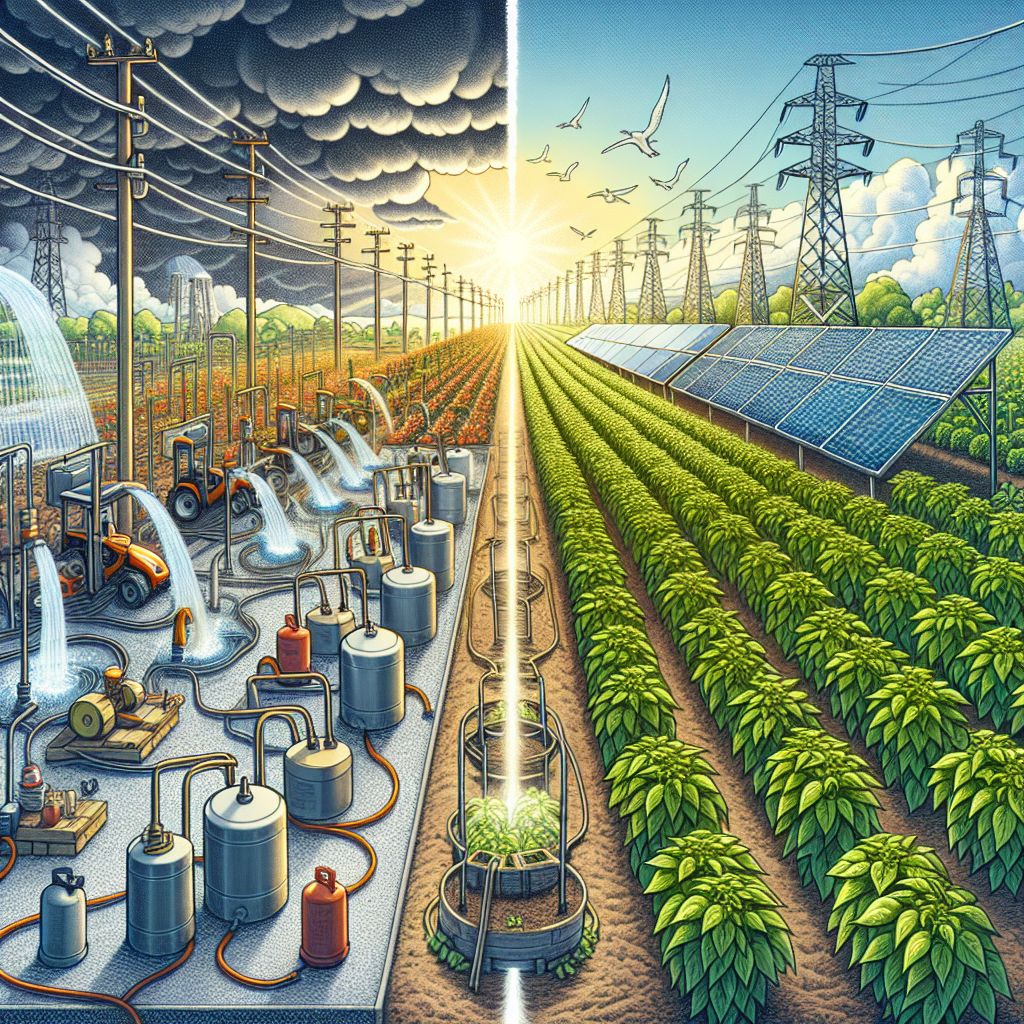
Comparing the Cost and Efficiency of Solar and Traditional Irrigation Systems for Pepper Cultivation
Choosing the right irrigation system can greatly affect the cost and efficiency of your pepper growing operation. While traditional irrigation systems may have lower upfront costs, they require ongoing expenses for electricity or fuel to operate the pumps. Solar irrigation systems, however, may have higher initial costs but can provide long-term savings and greater efficiency.
Initial Costs of Solar Systems
Although a solar irrigation system requires an upfront investment, the subsequent reduction in operational costs makes it a worthwhile expenditure. Solar panels can last for 20-25 years, providing free energy to power your irrigation system and significantly decreasing your farm’s energy costs over time.
Cost Comparison: Solar and Non-Solar Operation
Let’s take a look at the costs of operation. A non-solar irrigation system will have ongoing costs for electricity or diesel, as well as maintenance and repair costs. In contrast, solar systems have very low running costs once they’ve been installed. They require little maintenance, and the energy they produce is free, leading to significant savings over time.
Coming up, we’ll look at the return on investment for solar irrigation systems, and hear from farmers who’ve made the change. They’ll give us a first-hand account of the real-world advantages of solar-powered watering systems for growing peppers.
ROI Evaluation: System Lifespan and Maintenance
In evaluating the return on investment (ROI) for solar irrigation systems, lifespan is a major consideration. Solar panels and related equipment, if well-maintained, can last for many years, making them a smart investment for long-term planning. Moreover, solar systems usually have low maintenance needs, adding to their attractiveness. Regular panel cleaning and occasional system component checks are generally all that’s required to keep the system operating effectively.
Another factor to consider is the potential for improved crop yields over time. A more dependable and efficient irrigation system can help your pepper plants to produce more consistently, which can increase your profits. This increase in productivity, along with the savings on energy costs, can result in a solid return on investment for solar irrigation systems.
Real Life Stories: Farmers’ Perspective on Solar Irrigation
It’s often said that experience is the best teacher. Consider the case of a pepper farmer in Arizona who transitioned to solar irrigation. They experienced a 30% boost in yield and a considerable decrease in water consumption. Thanks to the energy bill savings and increased income from the higher yield, the farmer was able to recover the initial cost of the solar panels in just a few years.
A small-scale organic pepper farmer in California is a prime example of the benefits of solar irrigation. They installed a solar-powered drip irrigation system and were able to save water and reduce their carbon footprint. This investment in sustainable farming practices appealed to environmentally conscious consumers who were willing to pay more for responsibly grown vegetables.
Wrapping Up:
Wrapping up, solar irrigation systems offer an impressive solution for pepper farmers who are keen on boosting efficiency, sustainability, and profitability. These systems utilize the sun’s power to deliver a steady water supply, lower operating expenses, and promote sustainable farming methods. Although the initial investment can be substantial, the long-term advantages—both financially and environmentally—make solar irrigation an intelligent decision for the future of agriculture.
As farming continues to change, it’s important to keep up with the latest technology like solar irrigation. This is not just to stay ahead of the competition, but also to ensure the world has enough food. For those who grow peppers, solar irrigation can lead to more produce, lower expenses, and less harm to the environment. All of this helps make a farm more successful and better for the planet.
Commonly Asked Questions
It’s natural to have questions about new technologies, and we’re here to answer them for you. Here are some common questions and their answers to help you understand solar irrigation systems better.
What is the Mechanism of Solar Irrigation Systems?
Photovoltaic (PV) panels are used in solar irrigation systems to absorb sunlight and transform it into electrical energy. This energy is used to operate a pump that extracts water from a source—such as a well, pond, or reservoir—and transports it to the irrigation system. The water can then be distributed to your pepper plants through a drip, soaker hose, or sprinkler system, depending on your needs.
Is it possible to convert any irrigation system to solar?
While most irrigation systems are suitable for solar conversion, it’s crucial to evaluate your current system’s compatibility and energy needs. Drip and soaker hose systems are especially good candidates for solar conversion because they use less energy. But with the right tools and a good plan, you can even convert larger sprinkler systems to solar.
You can ask a solar expert or an agricultural extension agent for advice on how to convert your irrigation system to solar power.
What Kind of Maintenance Do Solar Irrigation Systems Need?
Maintaining a solar irrigation system is pretty simple and usually involves:
Regularly clean the solar panels to maintain their efficiency.
If your system includes storage, check the batteries to make sure they are holding a charge.
Check the pump and other mechanical parts for signs of wear and tear.
Make sure the irrigation lines are clear of blockages and leaks.
Keep in mind, good maintenance not only prolongs the life of your solar irrigation system, but it also maximizes its performance, ensuring that your peppers get the water they need to thrive.
By keeping up with these simple tasks, you can keep your solar irrigation system running smoothly for many years.
Does Solar Irrigation for Pepper Plants Make Financial Sense in Overcast Weather?
Indeed, solar irrigation can be financially viable in overcast weather, although it may necessitate a greater quantity of panels or the inclusion of battery storage to make up for the infrequent sunlight. Solar panels have become more efficient due to advancements in solar technology, even under low-light conditions. Furthermore, the money saved on water and energy over time can compensate for the initial outlay in areas where sunshine is less reliable.
How to Determine the Size of the Solar Panel System You Need?
To figure out the size of the solar panel system you need for your farm, take the following into account:
How much power your irrigation pump needs.
How much sunlight your area gets on average each day.
How efficient the solar panels you’re thinking about are.
Any other energy needs you might have on your farm.
You can get help figuring out what size system would be best for your particular needs and circumstances from a solar energy provider or agricultural extension service.
With this information, you can now make educated choices about incorporating solar energy into your pepper farm’s irrigation methods. Adopting solar irrigation is not just about staying current; it’s about ensuring a sustainable, successful future for your farm.







Leave a Reply